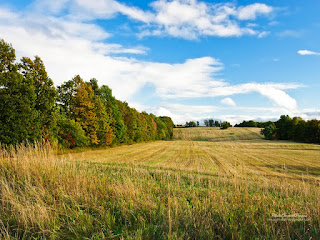In Traditional Oriental Medicine (and Macrobiotic theory) there is a fifth season known as "Late Summer" or the "Earth" time of year. And we are currently right in the middle of this amazing time of year! Late summer, according to the Five Transformations of Energy, is that incredible time when all of the energy from summer (when the energy of Earth is at its highest) begins its graceful back downwards, beginning to collect and gather and become solid again. The earth becomes drier but still contains some verdant freshness. This has a profound affect on our mood and emotions, health, and (of course!) the foods we eat.
The Emotions of Late Summer
This time of year most strongly influences the functioning of our spleen-stomach and pancreas. These organs, in addition to their obvious physiological functions, govern aspects of our emotional health as well. The emotions of worry and jealously and pensive thinking are controlled by the health and energies of these Earth organs. When our Earth energy is in balance, we feel calm, centered, dare I say Zen? When out of balance, we feel overcome with anxiety and worried, racing thoughts and jealously of the perceived happiness, health, and calm of others.
The Foods of Late Summer
To help balance the building Earth energy within ourselves, choosing appropriate foods (and avoiding those less appropriate) help us to thrive at this time of year. The flavor of the Earth element is sweet. And by that, I mean a naturally sweet taste. Foods that have a gentle, natural, unadulterated sweet flavor help to strengthen and balance our Earth energies. These include:
- Millet
- Onions
- Green Cabbage
- Parsnip
- Pumpkin
- Sweet Potato
- Carrots
- Sweet Brown Rice
- Summer Squash
- Cantaloupe
- Chickpeas
Using more of these foods in your cooking brings a quality into our system that can rebuild and maintain our hearty Earth energy. In addition, cooking styles that emphasize more stewing, braising, and other moist cooking are more appropriate that the cooking styles of the summer (like raw summer salads, raw fruits, juices, smoothies, and other cooling styles). Foods that are intensely sweet, or artificially sweet, over stimulate the Earth organs and cause our Late Summer energies to become erratic and racing. Taking time to chew, and engaging in calming, soothing activities all help to nourish ourselves during this important transition in time.
To help get your body and mind in balance as we transition from summer to fall, try a bowl of my Earth Energy Soup a few times a week to help relax the middle organs of the body, stabilize blood sugar, and vitalize your Earth Energy in the body to have a happy and healthy Late Summer!
Earth
Energy Soup
Makes 4-5 servings
Soothes
the stomach, alkalizes the blood and fluids, regulates blood sugar, and
improves digestion.
1
teaspoon toasted sesame seed oil
1
teaspoon turmeric powder
2
carrots, diced
1
cup chopped butternut squash or pumpkin
1
cup chopped sweet potato (do not peel)
1
clove of garlic, minced
1
tablespoon chopped or grated fresh ginger
2-inch
piece kombu sea vegetable
4
cups of filtered water
1
tablespoon chickpea or barley miso (depending on your needs/preference)
¼
cup watercress leaves (optional)
Sea
Salt
In
a medium-sized pot, add the sesame seed
oil and turmeric and place over medium heat.
Once the turmeric becomes fragrant, add the onion with a small pinch of
sea salt. Sautee for 1-2 minutes, then add the carrots with another small pinch
of salt. Cook 1-2 minutes, add the
squash/pumpkin with another pinch of salt, and cook for 3-5 minutes. Next, add the sweet potato, garlic, and
ginger with another pinch of salt and cook for another 3 minutes. Add the kombu
and water, cover, and bring to a boil.
Reduce heat to a simmer and cook for 15-20 minutes. Transfer soup to a
blender, food processor, or use a stick blender and process until smooth and
creamy. Remove soup from heat. In a small bowl, dissolve the miso with warm
water and mix into the soup once all boiling has stopped. Allow to sit for 1-2 minutes, and transfer to
serving bowls. Garnish with watercress
and serve.



